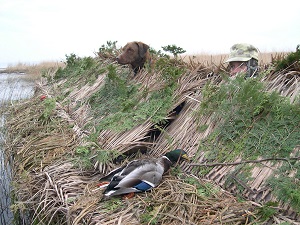
MONTPELIER, Vt. – Waterfowl hunters who will have retrieving dogs with them during Vermont’s waterfowl hunting seasons should check waterbodies for cyanobacteria (also known as blue-green algae) blooms before allowing their dogs in the water according to the Vermont Agency of Natural Resources.
Cyanobacteria can produce toxins that are hazardous to dogs. Each year, there are several reports of dog deaths around the country caused by cyanobacteria.
“While cooler weather may knock down existing blooms on some lakes, the same weather may stimulate blooms on other lakes,” said Angela Shambaugh, an environmental scientist with the Agency of Natural Resources. “As waterfowl season gets underway, waterfowl hunters should know to keep their dogs away from cyanobacteria blooms. Because many of them are out on the water well before daylight, they should consider checking conditions the day before.”
“Don’t let pets or livestock swim in or drink from areas where the water is discolored or where you see foam, scum or mats of cyanobacteria on the water’s surface,” she added. “The Vermont Department of Health maintains an online map of cyanobacteria blooms reported around the state and on Lake Champlain. Visit their webpage to view the map and watch their video to learn how to recognize cyanobacteria.” The Health Department also has a fact sheet for veterinarians and pet owners.
Vermont’s youth waterfowl hunting weekend is September 29 and 30, and the regular season for duck and goose hunting begins October 13.
For Immediate Release: September 26, 2018
Media Contact: Angela Shambaugh, Agency of Natural Resources -- 802-490-6130
